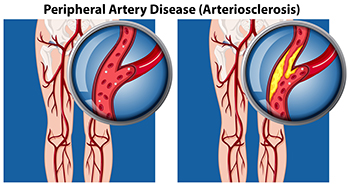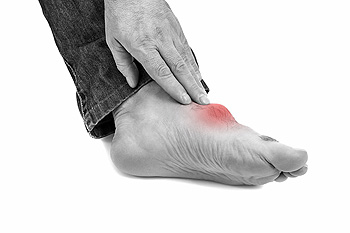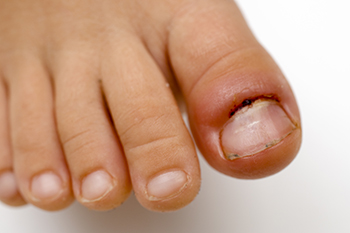Items filtered by date: July 2023
Effects of Peripheral Artery Disease on the Feet

Peripheral artery disease, or PAD, results from a buildup of fatty deposits in the arteries that restrict blood supply to the lower extremities. As the blood vessels narrow, the feet are unable to receive the normal amount of oxygenated blood that is needed to keep them healthy, and studies show that people over the age of 60 have a significantly increased chance of developing PAD. Men are also more at risk than women. The most common risk factors for developing peripheral artery disease are smoking, excessive alcohol consumption, diabetes, and high cholesterol. Symptoms of peripheral artery disease include loss of hair on extremities, weakness in the legs, brittle toenails, and shiny skin. Certain lifestyle changes can help to reduce the effects of PAD. If left untreated, PAD also can lead to serious or life-threatening conditions, such as heart disease or stroke. If you notice a loss of sensation in the feet or legs, a burning or prickling feeling, or a change of color in the feet or toes, it is suggested that you make an appointment with a podiatrist for an exam and options for treatment.
Peripheral artery disease can pose a serious risk to your health. It can increase the risk of stroke and heart attack. If you have symptoms of peripheral artery disease, consult with Amir Shalev, DPM from Complete Foot & Ankle Care. Our doctor will assess your condition and provide you with quality foot and ankle treatment.
Peripheral artery disease (PAD) is when arteries are constricted due to plaque (fatty deposits) build-up. This results in less blood flow to the legs and other extremities. The main cause of PAD is atherosclerosis, in which plaque builds up in the arteries.
Symptoms
Symptoms of PAD include:
- Claudication (leg pain from walking)
- Numbness in legs
- Decrease in growth of leg hair and toenails
- Paleness of the skin
- Erectile dysfunction
- Sores and wounds on legs and feet that won’t heal
- Coldness in one leg
It is important to note that a majority of individuals never show any symptoms of PAD.
Diagnosis
While PAD occurs in the legs and arteries, Podiatrists can diagnose PAD. Podiatrists utilize a test called an ankle-brachial index (ABI). An ABI test compares blood pressure in your arm to you ankle to see if any abnormality occurs. Ultrasound and imaging devices may also be used.
Treatment
Fortunately, lifestyle changes such as maintaining a healthy diet, exercising, managing cholesterol and blood sugar levels, and quitting smoking, can all treat PAD. Medications that prevent clots from occurring can be prescribed. Finally, in some cases, surgery may be recommended.
If you have any questions, please feel free to contact our office located in Las Vegas, NV . We offer the newest diagnostic and treatment technologies for all your foot care needs.
Heel Pain Can Be Treated!
Gout Demystified

Gout is an inflammatory arthritis that occurs due to excess buildup of uric acid crystals that settle in joints and soft tissue. When the body breaks down the naturally occurring substance in the body and from certain foods, called purines, it produces uric acid. Usually, the kidneys excrete excess uric acid through the urine, but if not enough is expelled, it can cause gout. This affliction often begins in the big toe, but it can also affect the heel of the foot. This affliction causes inflammation, pain, and joint stiffness. Some experiencing gout might notice swelling and discoloration of the affected joint. Gout attacks happen unexpectedly, often in the nighttime, and can be intensely painful. It is said that the pain can be so severe that it can be hard to endure the weight of a blanket. A flare can last from a few days to weeks. Gout can be inherited, but males, women of postmenopausal age, those on certain medications, like diuretics, or having other medical conditions, such as diabetes or high blood pressure, are more likely to experience gout. Those who are overweight or eat diets rich in purines, like seafood, red meat, and alcohol, can be at a higher risk of gout as well. If you have extreme pain in your foot, it is strongly suggested that you see a podiatrist for an examination, proper diagnosis, and treatment to help you regain comfort.
Gout is a foot condition that requires certain treatment and care. If you are seeking treatment, contact Amir Shalev, DPM from Complete Foot & Ankle Care. Our doctor will treat your foot and ankle needs.
What Is Gout?
Gout is a type of arthritis caused by a buildup of uric acid in the bloodstream. It often develops in the foot, especially the big toe area, although it can manifest in other parts of the body as well. Gout can make walking and standing very painful and is especially common in diabetics and the obese.
People typically get gout because of a poor diet. Genetic predisposition is also a factor. The children of parents who have had gout frequently have a chance of developing it themselves.
Gout can easily be identified by redness and inflammation of the big toe and the surrounding areas of the foot. Other symptoms include extreme fatigue, joint pain, and running high fevers. Sometimes corticosteroid drugs can be prescribed to treat gout, but the best way to combat this disease is to get more exercise and eat a better diet.
If you have any questions please feel free to contact our office located in Las Vegas, NV . We offer the newest diagnostic and treatment technologies for all your foot and ankle needs.
Toe Infections

A toe infection can start small and end up big in terms of pain and serious consequences if not tended to. Such an infection can arise from an injury, an unrelated medical condition, a nail problem like an ingrown toenail, wearing shoes that are too tight, or bacteria. Symptoms beyond pain include pressure, swelling, redness, oozing, a bad smell, and being hot to the touch. One might see a visible break in the skin and have a fever as well. Being a diabetic can make dealing with toe infections particularly difficult. In severe cases, this type of infection can lead to a toe amputation. Prevention is key to treating toe infections. Toes, in between toes, and toenails should be checked frequently for any abnormalities. Feet should be kept clean, and socks changed often. Toenails should be cut straight across and not too short. Going barefoot should be avoided. Shoes should be roomy enough that toes can wiggle freely. If you develop a toe infection, it is strongly suggested that you see a podiatrist as soon as possible for treatment.
Wound care is an important part in dealing with diabetes. If you have diabetes and a foot wound or would like more information about wound care for diabetics, consult with Amir Shalev, DPM from Complete Foot & Ankle Care. Our doctor will assess your condition and provide you with quality foot and ankle treatment.
What Is Wound Care?
Wound care is the practice of taking proper care of a wound. This can range from the smallest to the largest of wounds. While everyone can benefit from proper wound care, it is much more important for diabetics. Diabetics often suffer from poor blood circulation which causes wounds to heal much slower than they would in a non-diabetic.
What Is the Importance of Wound Care?
While it may not seem apparent with small ulcers on the foot, for diabetics, any size ulcer can become infected. Diabetics often also suffer from neuropathy, or nerve loss. This means they might not even feel when they have an ulcer on their foot. If the wound becomes severely infected, amputation may be necessary. Therefore, it is of the upmost importance to properly care for any and all foot wounds.
How to Care for Wounds
The best way to care for foot wounds is to prevent them. For diabetics, this means daily inspections of the feet for any signs of abnormalities or ulcers. It is also recommended to see a podiatrist several times a year for a foot inspection. If you do have an ulcer, run the wound under water to clear dirt from the wound; then apply antibiotic ointment to the wound and cover with a bandage. Bandages should be changed daily and keeping pressure off the wound is smart. It is advised to see a podiatrist, who can keep an eye on it.
If you have any questions, please feel free to contact our office located in Las Vegas, NV . We offer the newest diagnostic and treatment technologies for all your foot care needs.
Dealing With an Ingrown Toenail

An ingrown toenail occurs when the nail of the big toe grows into the surrounding nail bed instead of over it. The main symptom of an ingrown toenail is pain, especially when wearing tight shoes and socks or putting pressure on the toe. If left untreated, the area around the ingrown toenail can become inflamed and red, while fluid builds up as a protective measure. If infected, white or yellow pus may form. The major cause of an ingrown toenail is improper foot care, particularly when the toenails are cut too short or rounded on the edges instead of straight across. Other causes are wearing shoes and socks that are too tight, an injury like stubbing the toe, or sweaty feet. Prevention of an ingrown toenail begins with keeping your feet clean and dry, changing socks regularly, and cutting toenails straight across. Next, wear comfortable shoes that allow the toes to move around rather than being squeezed together. If an ingrown toenail becomes too painful or infected, it is suggested that you make an appointment with a podiatrist who can determine the best treatment.
Ingrown toenails can become painful if they are not treated properly. For more information about ingrown toenails, contact Amir Shalev, DPM of Complete Foot & Ankle Care. Our doctor can provide the care you need to keep you pain-free and on your feet.
Ingrown Toenails
Ingrown toenails occur when a toenail grows sideways into the bed of the nail, causing pain, swelling, and possibly infection.
Causes
- Bacterial infections
- Improper nail cutting such as cutting it too short or not straight across
- Trauma to the toe, such as stubbing, which causes the nail to grow back irregularly
- Ill-fitting shoes that bunch the toes too close together
- Genetic predisposition
Prevention
Because ingrown toenails are not something found outside of shoe-wearing cultures, going barefoot as often as possible will decrease the likeliness of developing ingrown toenails. Wearing proper fitting shoes and using proper cutting techniques will also help decrease your risk of developing ingrown toenails.
Treatment
Ingrown toenails are a very treatable foot condition. In minor cases, soaking the affected area in salt or antibacterial soaps will not only help with the ingrown nail itself, but also help prevent any infections from occurring. In more severe cases, surgery is an option. In either case, speaking to your podiatrist about this condition will help you get a better understanding of specific treatment options that are right for you.
If you have any questions please feel free to contact our office located in Las Vegas, NV . We offer the newest diagnostic and treatment technologies for all your foot and ankle needs.

